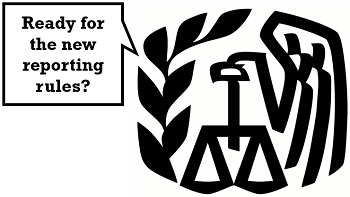 BARB RAND
BARB RAND
HNI Compliance Advisor
Some employers are facing two new reporting requirements this year mandated by the Affordable Care Act.
These are new reporting rules set out in Internal Revenue Code Sections 6055 and 6056. In a nutshell, these sections call for some employers to report to the IRS information about employer-sponsored health coverage.
The administrative side of 6055 and 6056 reporting will be challenging for employers. And failure to comply with the reporting rules could come with a big price tag.
Let's take a fast look at each section's reporting rules:
What You Need to Know About 6055
The goal of Section 6055 is to determine whether (and under which months) individuals were covered by minimum essential coverage. Section 6055 calls for the health plan issuer (the insurance company, if you're fully insured, or the employer, if you sponsor a self-insured plan) that provides minimum essential coverage to an individual during the calendar year to deliver/file two documents:
1.) Form 1095-B, an information return — to be delivered to the covered individual and filed with the IRS
2.) Form 1094-B, a transmittal form — to be filed with the IRS
What You Need to Know About 6056
Section 6056 is for applicable large employers — employers with at least 50 full-time employees. As you are likely aware, applicable large employers are required to offer health coverage that meets quality and affordability standards as part of the "pay or play" provisions of the ACA.
The forms associated with 6056 are how the IRS is verifying whether you met your requirements and whether they need to be paying out subsidies for any employees that didn't get adequate coverage through you.
Section 6056 calls for applicable large employers to file/deliver two different documents:
1.) Form 1095-C, an information return — to be delivered to the employee and filed with the IRS
2.) Form 1094-C, a transmittal form
Self-insured employers that are also applicable large employers (and thus must meet both the 6055 and 6056 reporting requirements) can use both sections of Form 1095-C and 1094-C to meet both requirements.
Where Things Get Tricky
Both of these forms call for information that isn't routinely captured by many HR databases. For example, 6055 calls for dependent information details.
In addition, 6056 requires employees' details and information about coverage offered and elected on a monthly basis; information about whether plans meet affordability tests; how cost sharing is structured; recording the reason why coverage wasn't offered to certain employees; and more. Adding to the complexity, the 6056 reporting is achieved by using various indicator codes.
Setting up a system now to start collecting and organizing this information is critical. We can't stress enough the value of setting up a system now to be able to comply with these requirements by the end of the year.
What Happens If You Don't Comply on 6055 and 6056 Reporting
Employers could face penalties of up to $200 per return for failure to comply with these reporting requirements. Positioning yourself to comply requires careful planning and potentially investing in new HR technology. Difficult as these new requirements may be, your compliance is on the line, and you've got to push through.
We want to help. HNI's webinar Jan. 20 on preparing for 6055 and 6056 reporting requirements helped attendees discover how to prepare for this change. As HNI's in-house compliance advisor, I shared a path for HR reporting compliance.
Couldn't make it to the session? Click here to watch the webinar on demand, or click the button below.
UPDATED FEB. 11, 2015: The forms and instructions now are final. They can be found via the following links:
The IRS also has shared best practices for tax preparers related to the individual shared responsibility provisions, including the follow advice:
Click here to read best practices from the IRS (PDF).
Related Posts:
ON-DEMAND WEBINAR: Doing More with Less: Developing a Self-Service Culture Using HR Technology
Latest IRS Forms Add to Health Care Reform Requirements for Employers
.png?width=69&height=53&name=Acrisure%20Logo%20(White%20Horizontal).png)


